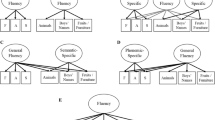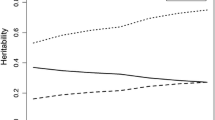Abstract
The current study investigated how the brain structure–function relationships between covert and overt verbal fluency in monozygotic handedness discordant (MzHd) twins relates to broader attentional measures. Evidence presented here shows that the structure–function correlation demonstrated between functional cerebral lateralisation and corpus callosum widths 22–39, contiguous with Broca’s area and the middle frontal gyri (Gurd et al. in Brain Struct Funct 218:491–509, 2013), is not an artefact of attention. Twenty-five pairs of female MzHd twins performed a verbal switching task titrated for number of switches. The paradigm permits calculation of switch rates and costs. The switch rate and cost varied as a function of number of switches (1, 2, 3). There were no differences in any measure in relation to right–left handedness in twin pairs. This was supported by large and significant within-twin pair correlations. Atypical functional lateralisation of inferior and middle frontal lobes does not appear to be associated with better or worse performance on verbal task-switching. Discordant lateralisation for verbal fluency does not predict behavioural performance profiles in MzHd twins. This evidence is compatible with a view that attentional components of verbal fluency task performance may have significant heritable components. It does not indicate that neural correlates of frontal cerebral laterality for verbal fluency in MzHd twins are significantly accountable for by heritable components.


Similar content being viewed by others
References
Amunts K, Lenzen M, Friederici AD, Schleicher A, Morosan P, Palomero-Gallagher N, Zilles K (2010) Broca’s region: novel organizational principles and multiple receptor mapping. PLoS Biol 8:1–16
Annett M (2003) Cerebral asymmetry in twins: predictions of the right shift theory. Neuropsychologia 41:469–479
Baddeley A (2000) Short-term and working memory. In: Tulving E, Craik FIM (eds) The Oxford handbook of memory. Oxford University Press, Oxford, pp 77–92
Birn RM, Kenworthy L, Case L, Caravella R, Jones TB, Bandettini PA, Martin A (2010) Neural systems supporting lexical search guided by letter and semantic category cues: a self-paced overt response fMRI study of verbal fluency. NeuroImage 49:1099–1107
Caramazza A (1986) On drawing inferences about the structure of normal cognitive systems from the analysis of patterns of impaired performance: the case for single-patient studies. Brain Cogn 5:41–66
Corey DM, Hurley MM, Foundas AL (2001) Right and left handedness defined: a multivariate approach using hand preference and hand performance measures. Neuropsychiatr Neuropsychol Behav Neurol 14:144–152
Engstrom M, Landtblom A-M, Karlsson T (2013) Brain and effort: brain activation and effort-related working memory in healthy participants and patients with working memory deficits. Front Hum Neurosci 7:1–17
Federenko E, Nieto-Castanon A, Kanwisher N (2012) Syntactic processing in the human brain: what we know, what we don’t know, and a suggestion for how to proceed. Brain Lang 120:187–207
Fink GR, Manjaly ZM, Stephan KE, Gurd JM, Zilles K, Amunts K, Marshall JC (2006) A role for Broca’s area beyond language processing: evidence from neuropsychology and fMRI. In: Grozinsky Y, Amunts K (eds) Broca’s region. Oxford University Press, Oxford, pp 254–268
Friedman NP, Miyake A, Young SE, DeFries JC, Corley RP, Hewitt JK (2008) Individual differences in executive functions are almost entirely genetic in origin. J Exp Psychol Gen 137:201–225
de la Fuente A, Zia S, Branch C, Li X (2013) A review of attention-deficit/hyperactivity disorder from the perspective of brain networks. Front Hum Neurosci 7:1–6
Goodglass H, Kaplan E (1972) The assessment of aphasia and related disorders. Lea and Febiger, Philadelphia, PA
Gruber O, Muller T, Falkai P (2007) Dynamic interactions between neural systems underlying different components of verbal working memory. J Neural Transm 114:1047–1050
Gurd JM, Cowell PE, Lux S, Rezaie R, Cherkas L, Ebers GC (2013) fMRI and corpus callosum relationships in monozygotic twins discordant for handedness. Brain Struct Funct 218:491–509
Gurd JM, Schulz J, Cherkas L, Ebers GC (2006) Hand preference and performance in 20 pairs of monozygotic twins with discordant handedness. Cortex 42:934–945
Gurd JM, Weiss PH, Amunts K, Fink GR (2003) Within-task switching in the verbal domain. NeuroImage 20:S50–S57
Gurd JM, Amunts K, Weiss PH, Zafiris O, Zilles K, Marshall JC, Fink GR (2002) Posterior parietal cortex is implicated in continuous switching between verbal fluency tasks: an fMRI study with clinical implications. Brain 125:1024–1038
Gurd JM (1995) Frontal dissociations: evidence from Parkinson’s disease. J Neurolinguistics 9:55–68
Hirshorn EA, Thompson-Schill SL (2006) Role of the left inferior frontal gyrus in covert word retrieval: neural correlates of switching during verbal fluency. Neuropsychologia 44:2547–2557
Kahneman D (2011) Thinking, fast and slow. Penguin Books, London
Kim C, Cilles SE, Johnson NF, Gold BT (2012a) Domain general and domain preferential brain regions associated with different types of task switching: a meta-analysis. Hum Brain Mapp 33:130–142
Kim C, Johnson NF, Gold BT (2012b) Common and distinct neural mechanisms of attentional switching and response conflict. Brain Res 1469:92–102
Li L, Wang M, Zhao Q-J, Fogelson N (2012) Neural mechanisms underlying the cost of task switching: an ERP study. PLoS ONE 7:1–13
Lux S, Keller S, Mackay C, Ebers GC, Marshall JC, Cherkas L, Rezaie R, Roberts N, Fink GR, Gurd JM (2008) Crossed cerebral lateralisation for verbal and visuo-spatial function in a pair of handedness discordant monozygotic twins: MRI and fMRI brain imaging. J Anat 212:235–248
Markett S, Montag C, Walter NT, Plieger T, Reuter M (2011) On the molecular genetics of flexibility: the case of task-switching, inhibitory control and genetic variants. Cogn Affect Behav Neurosci 11:644–651
McGraw KO, Wong SP (1996) Forming inferences about some intraclass correlation coefficients. Psychol Methods 1:30–46
McManus IC, Davison A, Armour JAL (2013) Multilocus genetic models of handedness closely resemble single-locus models in explaining family data and are compatible with genome-wide association studies. Ann NY Acad Sci 1288:48–58
Paulesu E, Goldacre B, Scifo P, Cappa SF, Gilardi MC, Castiglioni I, Perani D, Fazio F (1997) Functional heterogeneity of left inferior frontal cortex as revealed by fMRI. NeuroReport 8:2011–2017
Peters M, Reimers S, Manning JT (2006) Hand preference for writing and associations with selected demographic and behavioural variables in 255,100 subjects: the BBC internet study. Brain Cogn 62:177–189
Rosch RE, Ronan L, Cherkas L, Gurd JM (2010) Analysis of cerebellar laterality in a single pair of monozygotic handedness discordant twins. J Anat 217:38–47
Shallice T (1988) From neuropsychology to mental structure. Cambridge University Press, Cambridge
Vuoksimaa E, Koskenvuo M, Rose RJ, Kaprio J (2009) Origins of handedness: a nationwide study of 30,161 adults. Neuropsychologia. 47:1294–1301
Willmes K (2010) The methodological and statistical foundations of neuropsychological assessment. In: Gurd JM, Kischka U, Marshall JC (eds) Handbook of clinical neuropsychology, 2nd edn. Oxford University Press, Oxford, UK, pp 28-49
Witt ST, Stevens MC (2013) fMRI task parameters influence hemodynamic activity in regions implicated in mental set switching. NeuroImage 65:139–151
Wylie G, Allport A (2000) Task switching and the measurement of ‘switch costs’. Psychol Res 63:212–233
Unpublished manuscript
Gurd JM (1993) Verbal fluency deficits in patients with Parkinson’s disease. Unpublished doctor of philosophy thesis, University of Oxford
Acknowledgments
We are grateful to the following funding organisations: the British Academy, the Critchley Charitable Trust, The Medical Research Council UK, and colleagues: to G.C. Ebers, T. Spector, L. Cherkas, S. Lux, C. MacKay, H. Burnham, F. Essig and H. Osborne, in addition to anonymous referees.
Author information
Authors and Affiliations
Corresponding author
Appendices
Appendix 1
Differences between RH and LH twins were computed for 2-, 3-, and 4-category switch rate and switch cost measures. Summary statistics are listed in Tables 3 and 4. Figures plotting the mean within-twin pair differences ± 95 % confidence intervals are plotted for switch rate (Fig. 3) and switch cost (Fig. 4). The figures show mean differences near zero, with confidence intervals spanning the zero line for all measures.
Appendix 2
Errors: Means (SD) per group and per condition were few in numbers and comparable in proportion, per number of categories between handedness groups:
ANOVA was conducted with Hand as the group measure, and switch error as the dependent measure. Effects of Hand (RH, LH) were not significant (F = 1.60, df = 1,143, p = 0.21, ns) (see Fig. 5).
Error type: Errors were analysed as to type according to a simplified procedure described in Gurd (1993, unpublished DPhil thesis), and reported as overall percentage of errors per handedness group, and were produced in comparable proportions:
Notes
Complete data sets (i.e. full runs) were available for 23 of the 25 twin pairs for analysis of switch rate (missing data for: RH_twin25 and LH_twin15 for switch rate 4). For switch cost analyses, 22 pairs had complete data sets (missing data for: RH_twin4, LH_twin15, RH_twin25, LH_twin25 and for switch cost 4). (Results from one further twin pair (tw_16) has already been reported (Lux et al. 2008). Their pattern of fMRI activations were unique and different, hence their data are not reproduced here.)
Rights and permissions
About this article
Cite this article
Gurd, J.M., Cowell, P.E. Discordant cerebral lateralisation for verbal fluency is not an artefact of attention: evidence from MzHd twins. Brain Struct Funct 220, 59–69 (2015). https://doi.org/10.1007/s00429-013-0637-0
Received:
Accepted:
Published:
Issue Date:
DOI: https://doi.org/10.1007/s00429-013-0637-0







